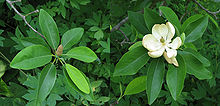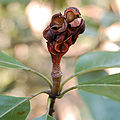- Magnolia virginiana
-
Magnolia virginiana
Sweetbay Magnolia
Scientific classification Kingdom: Plantae (unranked): Angiosperms (unranked): Magnoliids Order: Magnoliales Family: Magnoliaceae Genus: Magnolia Subgenus: Binomial name Magnolia virginiana
L.
Magnolia virginiana, most commonly known as sweetbay magnolia, or merely sweetbay (also swampbay, swamp magnolia, whitebay, or beaver tree), is a member of the magnolia family, Magnoliaceae. It was the first magnolia to be scientifically described under modern rules of botanical nomenclature, and is the type species of the genus Magnolia; as Magnolia is also the type genus of all flowering plants (magnoliophytes), this species in a sense typifies all flowering plants.
Contents
Description
Magnolia virginiana is a deciduous or evergreen tree to 30 m tall, native to the southeastern United States. Whether it is deciduous or evergreen depends on climate; it is evergreen in areas with milder winters in the south of its range, and is semi-evergreen or deciduous further north. The leaves are alternate, simple (not lobed or pinnate), with entire margins, 6-12 cm long, and 3-5 cm wide. The bark is smooth and gray, with the inner bark mildly scented, the scent reminiscent of the bay laurel spice.
The flowers are creamy white, 8-14 cm diameter, with 6-15 petal-like tepals. The flowers carry a very strong vanilla scent that can sometimes be noticed several hundred yards away. The fruit is a fused aggregate of follicles, 3-5 cm long, pinkish-red when mature, with the follicles splitting open to release the 1 cm long seeds. The seeds are black but covered by a thinly fleshy red coat, which is attractive to some fruit-eating birds; these swallow the seeds, digest the red coating, and disperse the seeds in their droppings.
Cultivation
Magnolia virginiana is often grown as an ornamental tree in gardens, and used in horticultural applications to give an architectural feel to landscape designs. It is an attractive tree for parks and large gardens, grown for its large, conspicuous, scented flowers, for its clean, attractive foliage, and for its fast growth. These handsome plants are not often damaged by ice storms[1].
The English botanist and missionary John Banister collected Magnolia virginiana in 1678 and sent it to England, where it flowered for Bishop Henry Compton. This species was the first magnolia to be cultivated in England, although it was soon overshadowed by the evergreen, larger-flowered southern magnolia (M. grandiflora.)[1]
The sweetbay magnolia has been hybridized horticulturally with a number of species within subgenus Magnolia. These species include M. globosa, M. grandiflora, M. insignis, M. macrophylla, M. obovata, M. sieboldii and M. tripetala. Some of these hybrids have been given cultivar names and registered by the Magnolia Society.
Gallery
External links
- Magnolia virginiana images at bioimages.vanderbilt.edu
- Interactive Distribution Map of Magnolia virginiana
References
Categories:- Magnolia
- Flora of the Southeastern United States
- Trees of Alabama
- Trees of North Carolina
- Trees of Virginia
- Trees of the Southeastern United States
- Garden plants of North America
- Bird food plants
- Ornamental trees
Wikimedia Foundation. 2010.






